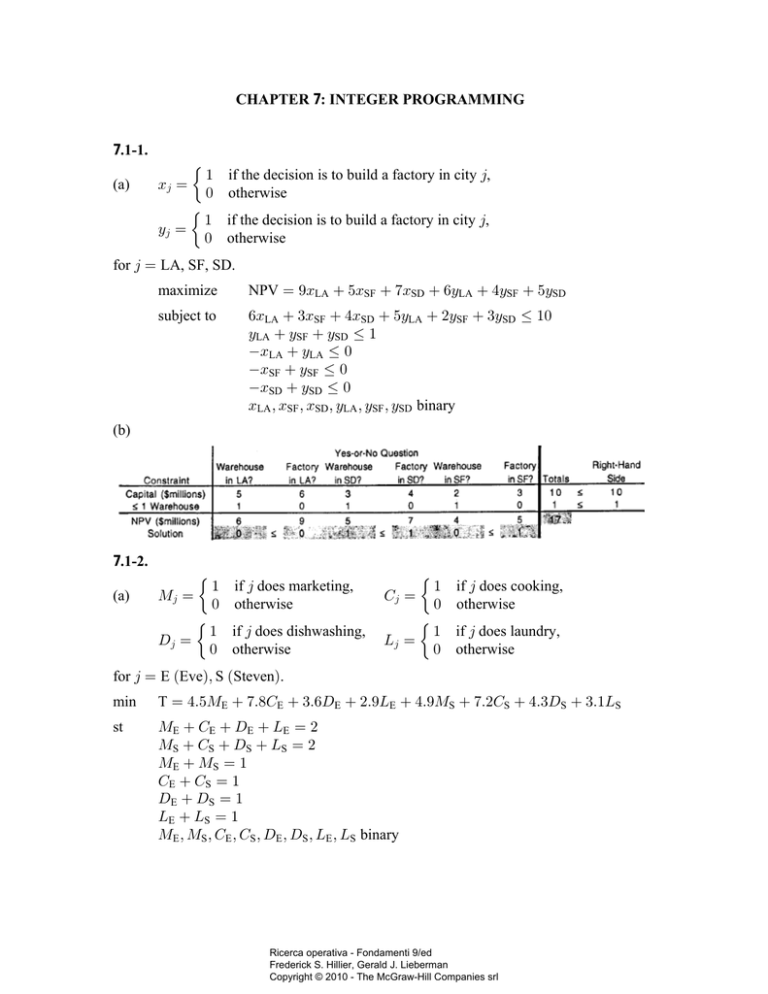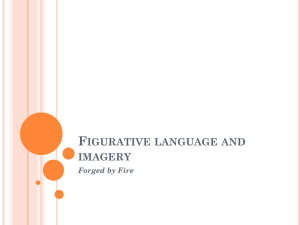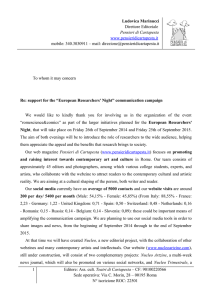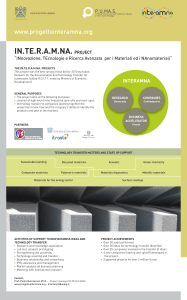44° campinverno golfo di napoli
advertisement

CHAPTER 7: INTEGER PROGRAMMING 7.1-1. (a) " if the decision is to build a factory in city 4, B4 œ œ ! otherwise " C4 œ œ ! if the decision is to build a factory in city 4, otherwise for 4 œ LA, SF, SD. maximize NPV œ *BLA &BSF (BSD 'CLA %CSF &CSD subject to 'BLA $BSF %BSD &CLA #CSF $CSD Ÿ "! CLA CSF CSD Ÿ " BLA CLA Ÿ ! BSF CSF Ÿ ! BSD CSD Ÿ ! BLA ß BSF ß BSD ß CLA ß CSF ß CSD binary (b) 7.1-2. (a) " Q4 œ œ ! " H4 œ œ ! if 4 does marketing, otherwise if 4 does dishwashing, otherwise " if 4 does cooking, G4 œ œ ! otherwise " P4 œ œ ! if 4 does laundry, otherwise for 4 œ E ÐEveÑß S ÐStevenÑ. min T œ %Þ&QE (Þ)GE $Þ'HE #Þ*PE %Þ*QS (Þ#GS %Þ$HS $Þ"PS st QE GE HE PE œ # QS GS HS PS œ # QE QS œ " GE GS œ " H E HS œ " PE PS œ " QE ß QS ß GE ß GS ß HE ß HS ß PE ß PS binary Ricerca operativa - Fondamenti 9/ed Frederick S. Hillier, Gerald J. Lieberman Copyright © 2010 - The McGraw-Hill Companies srl (b) 11.1-3. (a) " if the decision is to invest in project 4, B4 œ œ ! otherwise for 4 œ "ß #ß $ß %ß &. maximize NPV œ B" "Þ)B# "Þ'B$ !Þ)B% "Þ%B& subject to 'B" "#B# "!B$ %B% )B& Ÿ #! B" ß B# ß B$ ß B% ß B& binary (b) - (c) 7.1.3 (a) B4 œ œ " if the decision is to invest in opportunity 4, ! otherwise for 4 œ "ß #ß $ß %ß &ß '. Let :4 denote the estimated profit of opportunity 4 and -4 the capital required for opportunity 4 in millions of dollars. ! B4 :4 ' maximize 4œ" ! B4 -4 Ÿ "!! ' subject to 4œ" B" B# Ÿ " B$ B% Ÿ " B$ Ÿ B" B# B% Ÿ B" B# B4 binary, for 4 œ "ß á ß ' Ricerca operativa - Fondamenti 9/ed Frederick S. Hillier, Gerald J. Lieberman Copyright © 2010 - The McGraw-Hill Companies srl (b) Solution: Invest in opportunities 1, 3 and 5. 11.1-5. Each swimmer can swim only one stroke and each stroke can be assigned to only one swimmer. 11.1-6. (a) Let X be the number of tow bars produced and W be the number of stabilizer bars produced. maximize T œ "$!X "&!W subject to $Þ#X #Þ%W Ÿ "' #X $W Ÿ "& X ß W ! integers Ricerca operativa - Fondamenti 9/ed Frederick S. Hillier, Gerald J. Lieberman Copyright © 2010 - The McGraw-Hill Companies srl 7.3.4 (a) Let Q be a very large number, say "!! million. max (!B" &!ß !!!C" '!B# %!ß !!!C# *!B$ (!ß !!!C$ )!B% '!ß !!!C% st C" C# C$ C% Ÿ # C$ Ÿ C" C# C% Ÿ C" C# &B" $B# 'B$ %B% Ÿ '!!! Q C& %B" 'B# $B$ &B% Ÿ '!!! Q Ð" C& Ñ ! Ÿ B3 Ÿ Q C3 , for 3 œ "ß #ß $ß % C3 binary, for 3 œ "ß #ß $ß % (b) 7.3.5 B" B# œ !C" $C# $C$ 'C% 'C& , C3 − Ö!ß "×, for 3 œ "ß á ß &. 11.3-3. 1. $B" B# B$ B% Ÿ "# Q C" B" B# B$ B% Ÿ "& Q Ð" C" Ñ C" binary 2. #B" &B# B$ B% Ÿ $! Q C# B" $B# &B$ B% Ÿ %! Q C$ $B" B# $B$ B% Ÿ '! Q C% C# C$ C% Ÿ " C3 binary, for 3 œ #ß $ß % Ricerca operativa - Fondamenti 9/ed Frederick S. Hillier, Gerald J. Lieberman Copyright © 2010 - The McGraw-Hill Companies srl 11.3-4. (a) Let C" and C# be binary variables that indicate whether or not toys 1 and 2 are produced. Let B" and B# be the number of toys 1 and 2 that are produced. Also, let D be ! if factory 1 is used and " if factory 2 is used. maximize "!B" "&B# &!ß !!!C" )!ß !!!C# subject to B" Ÿ Q C" B# Ÿ Q C# " &! B" " %! B# Ÿ &!! Q D " %! B" " #& B# Ÿ (!! Q Ð" DÑ B" ß B# ! integers C" ß C# ß D binary (b) 7.3.7 (a) Let P, Q , and W be the number of long-, medium-, and short-range jets to buy respectively. maximize T œ %Þ#P $Q #Þ$W subject to '(P &!Q $&W Ÿ "&!! P Q W Ÿ $! & $P %$ Q W Ÿ %! Pß Q ß W ! integers Ricerca operativa - Fondamenti 9/ed Frederick S. Hillier, Gerald J. Lieberman Copyright © 2010 - The McGraw-Hill Companies srl (b) (c) $! %! P Ÿ minš "&!! '( ß " ß &Î$ › œ #% $! %! Q Ÿ minš "&!! &! ß " ß %Î$ › œ $! $! %! W Ÿ minš "&!! $& ß " ß " › œ $! P œ #! 6! #" 6" ## 6# #$ 6$ #% 6% Q œ #! 7! #" 7" ## 7# #$ 7$ #% 7% W œ #! =! #" =" ## =# #$ =$ #% =% T œ %Þ#! #3 63 $! #3 73 #Þ$! #3 =3 % maximize % 3œ! subject to % 3œ! 3œ! '(! #3 63 &!! #3 73 $&! #3 =3 Ÿ "&!! % % % 3œ! 3œ! 3œ! ! #3 63 ! #3 73 ! #3 =3 Ÿ $! % % % 3œ! 3œ! 3œ! % &! 3 # 63 $ 3œ! %$ ! #3 73 ! #3 =3 Ÿ %! % % 3œ! 3œ! 63 ß 73 ß =3 binary, for 3 œ !ß "ß #ß $ß % (d) Solution: 6! œ 6% œ !ß 6" œ 6# œ 6$ œ "ß !%3œ! #3 63 œ "% 7! œ 7" œ 7# œ 7$ œ 7% œ !ß !%3œ! #3 73 œ ! =! œ =" œ =# œ =$ œ !ß =% œ "ß !%3œ! #3 =3 œ "' T œ $*&Þ' (same as in (b)) 11.3-6. (a) B" œ C"" #C"# ß B# œ C#" #C## maximize ^ œ C"" #C"# &C#" "!C## subject to C"" #C"# "!C#" #!C## Ÿ #! C"" #C"# Ÿ # C34 binary, for 3ß 4 œ "ß # (b) Solution: C"" œ C"# œ ! Ê B" œ !, C#" œ !, C## œ " Ê B# œ #, ^ œ "! Ricerca operativa - Fondamenti 9/ed Frederick S. Hillier, Gerald J. Lieberman Copyright © 2010 - The McGraw-Hill Companies srl 7.3.8 (a) Let B3 be the number of units to produce of product 3 œ "ß #ß $. C3 œ œ " ! if product 3 is produced, otherwise maximize #B" $B# !Þ)B$ $C" #C# subject to !Þ#B" !Þ%B# !Þ#B$ Ÿ " B" Ÿ Q C" B# Ÿ Q C# ! Ÿ B" Ÿ $ integer ! Ÿ B# Ÿ # integer ! Ÿ B$ Ÿ & integer C" ß C# binary (b) 11.4-1. (a) C34 œ œ " ! if B3 œ 4 (i.e., produce 4 units of 3), otherwise for 3 œ "ß #ß $ and 4 œ "ß #ß $ß %ß &. max C"" #C"# %C"$ C#" &C## C$" $C$# &C$$ 'C$% (C$& st C"" C"# C"$ Ÿ " C#" C## Ÿ " C$" C$# C$$ C$% C$& Ÿ " C"" #C"# $C"$ #C#" %C## C$" #C$# $C$$ %C$% &C$& Ÿ & C34 binary (b) Solution: C34 œ ! except for Ð3ß 4Ñ œ Ð$ß &Ñ, C$& œ " Ê B$ œ &, ^ œ ( (c) C34 œ œ " ! if B3 4, otherwise for 3 œ "ß #ß $ and 4 œ "ß #ß $ß %ß &. Ricerca operativa - Fondamenti 9/ed Frederick S. Hillier, Gerald J. Lieberman Copyright © 2010 - The McGraw-Hill Companies srl 7.4.9 (a) Let C" and C# be binary variables that indicate whether or not toys 1 and 2 are produced. Let B" and B# be the number of toys 1 and 2 that are produced. Also, let D be ! if factory 1 is used and " if factory 2 is used. maximize "!B" "&B# &!ß !!!C" )!ß !!!C# subject to B" Ÿ Q C" B# Ÿ Q C# " &! B" " %! B# Ÿ &!! Q D " %! B" " #& B# Ÿ (!! Q Ð" DÑ B" ß B# ! integers C" ß C# ß D binary (b) 7.3.7 (a) Let P, Q , and W be the number of long-, medium-, and short-range jets to buy respectively. maximize T œ %Þ#P $Q #Þ$W subject to '(P &!Q $&W Ÿ "&!! P Q W Ÿ $! & $P %$ Q W Ÿ %! Pß Q ß W ! integers Ricerca operativa - Fondamenti 9/ed Frederick S. Hillier, Gerald J. Lieberman Copyright © 2010 - The McGraw-Hill Companies srl 7.3.8 (a) Let B3 be the number of units to produce of product 3 œ "ß #ß $. C3 œ œ " ! if product 3 is produced, otherwise maximize #B" $B# !Þ)B$ $C" #C# subject to !Þ#B" !Þ%B# !Þ#B$ Ÿ " B" Ÿ Q C" B# Ÿ Q C# ! Ÿ B" Ÿ $ integer ! Ÿ B# Ÿ # integer ! Ÿ B$ Ÿ & integer C" ß C# binary (b) 7.4.10 (a) C34 œ œ " ! if B3 œ 4 (i.e., produce 4 units of 3), otherwise for 3 œ "ß #ß $ and 4 œ "ß #ß $ß %ß &. max C"" #C"# %C"$ C#" &C## C$" $C$# &C$$ 'C$% (C$& st C"" C"# C"$ Ÿ " C#" C## Ÿ " C$" C$# C$$ C$% C$& Ÿ " C"" #C"# $C"$ #C#" %C## C$" #C$# $C$$ %C$% &C$& Ÿ & C34 binary (b) Solution: C34 œ ! except for Ð3ß 4Ñ œ Ð$ß &Ñ, C$& œ " Ê B$ œ &, ^ œ ( (c) C34 œ œ " ! if B3 4, otherwise for 3 œ "ß #ß $ and 4 œ "ß #ß $ß %ß &. Ricerca operativa - Fondamenti 9/ed Frederick S. Hillier, Gerald J. Lieberman Copyright © 2010 - The McGraw-Hill Companies srl max C"" $C"# #C"$ C#" %C## C$" #C$# #C$$ C$% C$& st C"$ Ÿ C"# Ÿ C"" C## Ÿ C#" C$& Ÿ C$% Ÿ C$$ Ÿ C$# Ÿ C$" C"" C"# C"$ #C#" #C## C$" C$# C$$ C$% C$& Ÿ & C34 binary (d) Solution: C34 œ ! for 3 œ "ß #, C$4 œ " for 4 œ "ß á ß & Ê B$ œ &, ^ œ ( 7.4.11 Introduce the binary variables C" and C# and add constraints B" Ÿ Q C" , B# Ÿ Q C# , C" C# œ ". 11.4-3. (a) Introduce the binary variables C" , C# , and C$ to represent positive (nonzero) production levels. maximize ^ œ &!B" #!B# #&B$ subject to *B" $B# &B$ Ÿ &!! &B" %B# Ÿ $&! $B" #B$ Ÿ "&! B$ Ÿ #! B" Ÿ Q C" , B# Ÿ Q C# , B$ Ÿ Q C$ C" C# C$ Ÿ # B" ß B# ß B$ ! C" ß C# ß C$ binary (b) 7.4.12 (a) " C34 œ œ ! if B3 œ 4, otherwise for 3 œ "ß # and 4 œ "ß #ß $. Work out by hand the objective function contribution for B" ß B# œ !ß "ß #ß $. Ricerca operativa - Fondamenti 9/ed Frederick S. Hillier, Gerald J. Lieberman Copyright © 2010 - The McGraw-Hill Companies srl maximize subject to $C"" )C"# *C"$ *C#" #%C## *C#$ C"" C"# C"$ Ÿ " C#" C## C#$ Ÿ " C"" C#$ Ÿ " C"$ C#$ Ÿ " C"# C#$ Ÿ " C"# C## Ÿ " C"$ C## Ÿ " C"$ C#" Ÿ " C34 binary (b) Solution: C34 œ ! except C"" œ C## œ " Ê B" œ ", B# œ #, ^ œ #( C34 œ œ (c) " ! if B3 4, otherwise for 3 œ "ß # and 4 œ "ß #ß $. Work out by hand the objective function contribution for B" ß B# œ !ß "ß #ß $. maximize subject to $C"" &C"# C"$ *C#" "&C## "&C#$ C"$ Ÿ C"# Ÿ C"" C#$ Ÿ C## Ÿ C#" C"" C#$ Ÿ " C"# C## Ÿ " C"$ C#" Ÿ " C34 binary (d) Solution: C34 œ ! except C"" œ C#" œ C## œ " Ê B" œ ", B# œ #, ^ œ #( 7.4.13 B34 œ œ (a) min st " ! if arc from node 3 to node 4 is in the shortest path, otherwise $B"# 'B"$ 'B#% &B#& %B$% $B$& $B%' #B&' B"# B"$ œ " (1) B#% B#& B$% B$& œ " (2) B%' B&' œ " (3) B#% B#& Ÿ B"# (4) B$% B$& Ÿ B"$ (5) B%' Ÿ B#% B$% (6) B&' Ÿ B#& B$& (7) B34 binary (1), (2), (3) ensure that exactly one arc is used at each stage and they represent mutually exclusive alternatives. (4), (5), (6) ensure that node 3 is left only if it is entered and they represent contingent decisions. (b) Solution: B34 œ ! except B"# œ B#& œ B&' œ ", ^ œ "! Shortest path: 1 Ä 2 Ä 5 Ä 6 Ricerca operativa - Fondamenti 9/ed Frederick S. Hillier, Gerald J. Lieberman Copyright © 2010 - The McGraw-Hill Companies srl 7.5.14 (a) The dots represent the feasible solutions in the graph below. Optimal Solution: ÐB" ß B# Ñ œ Ð#ß $Ñß ^ œ &B" B# œ "$ (b) The optimal solution of the LP relaxation is ÐB" ß B# Ñ œ Ð#Þ'ß "Þ'Ñß ^ œ "%Þ'. The nearest integer point is ÐB" ß B# Ñ œ Ð$ß #Ñ, which is not feasible, since % † $ # "#. Rounded Solutions Ð$ß #Ñ Ð$ß "Ñ Ð#ß #Ñ Ð#ß "Ñ Violated Constraints 3rd 2nd and 3rd none none ^ "# "" Hence, none of the feasible rounded solutions is optimal for the IP problem. 11.5-3. (a) The dots represent the feasible solutions in the graph below. Optimal Solution: ÐB" ß B# Ñ œ Ð#ß $Ñß ^ œ ##!B" )!B# œ ')! Ricerca operativa - Fondamenti 9/ed Frederick S. Hillier, Gerald J. Lieberman Copyright © 2010 - The McGraw-Hill Companies srl (b) The optimal solution of the LP relaxation is ÐB" ß B# Ñ œ Ð!ß !Þ*Ñ. The nearest integer point is ÐB" ß B# Ñ œ Ð!ß "Ñ, which is not feasible. The other rounded solution is Ð!ß !Ñ, which is feasible, but not optimal. 7.5.16 (a) TRUE, Sec. 11.5, 4th paragraph, p. 501. (b) TRUE, Sec. 11.5, 9th paragraph, p. 502. (c) FALSE, the result need not be feasible, see Fig. 11.2 for a counterexample, p. 503. Sec. 11.5, 11th paragraph explains this pitfall. Ricerca operativa - Fondamenti 9/ed Frederick S. Hillier, Gerald J. Lieberman Copyright © 2010 - The McGraw-Hill Companies srl 7.6.17 Optimal Solution: Ð!ß !ß "ß "ß "Ñ, ^ œ ' 7.6.18 Optimal Solution: Ð"ß !ß "ß !ß !Ñ, ^ œ "# Ricerca operativa - Fondamenti 9/ed Frederick S. Hillier, Gerald J. Lieberman Copyright © 2010 - The McGraw-Hill Companies srl 11.6-5. 7.6.19 (a) FALSE. The feasible region for the IP problem is a subset of the feasible region for the LP relaxation. It is called a relaxation because it relaxes the feasible region. (b) TRUE. If the optimal solution for the LP relaxation is integer, then it is feasible for the IP problem and since the solution for the latter cannot be better than the solution for the former, it has to be optimal. (c) FALSE. Figure 11.2 is a counterexample for this statement. 7.6.20 (a) Initialization: Set ^ ‡ œ _. Apply the bounding and fathoming steps and the optimality test as described below for the whole problem. If the whole problem is not fathomed, then it becomes the initial subproblem for the first iteration below. Iteration: 1. Branching: Choose the most recently created unfathomed subproblem (in case of a tie, select the one with the smallest bound). Among the assignees not yet assigned for the current subproblem, choose the first one in the natural ordering to be the branching variable. Subproblems correspond to each of the possible remaining assignments for the branching assignee. Form a subproblem for each remaining assignment by deleting the constraint that each of the unassigned assignees must perform exactly one assignment. 2. Bounding: For each new subproblem, obtain its bound by choosing the cheapest assignee for each remaining assignment and totaling the costs. 3. Fathoming: For each new subproblem, apply the two fathoming tests: Test 1. bound ^ ‡ Test 2. The optimal solution for its relaxation is a feasible assignment (If this solution is better than the incumbent, it becomes the new incumbent and Test 1 is reapplied to all unfathomed subproblems with the new smaller ^ ‡ ). Optimality Test: Identical to the one given in the text. Ricerca operativa - Fondamenti 9/ed Frederick S. Hillier, Gerald J. Lieberman Copyright © 2010 - The McGraw-Hill Companies srl (b) Matchings are indicated with the notation (assignee, assignment). Optimal matching: Ð"ß "Ñß Ð#ß $Ñß Ð$ß #Ñß Ð%ß %Ñß Ð&ß &Ñ, with total cost "&%. Ricerca operativa - Fondamenti 9/ed Frederick S. Hillier, Gerald J. Lieberman Copyright © 2010 - The McGraw-Hill Companies srl 11.6-8. (a) Branch Step: Use the best bound rule. Bound Step: Given a partial sequencing N" ß á ß N5 of the first 5 jobs, a lower bound on the time for the setup of the remaining & 5 jobs is found by adding the minimum elements of the columns corresponding to the remaining jobs, excluding those elements in rows "None", N" ß N# ß á ß N5" . Fathoming Step: see the summary of the Branch-and-Bound technique in Sec. 11.6. (b) The optimal sequence is # " % & $, with a total setup time of $'. 11.6-9. Optimal Solution: ÐB" ß B# ß B$ ß B% Ñ œ Ð!ß "ß "ß !Ñ, ^ ‡ œ $' 7.6.21 (a) The only constraints of the Lagrangian relaxation are nonnegativity and integrality. Since x is feasible for an MIP problem, it already satisfies these constraints, so it is feasible for the corresponding Lagrangian relaxation. (b) x‡ is feasible for an MIP problem, so from (a), it has to be feasible for its Lagrangian relaxation. Also, Ex‡ Ÿ , and - !, so ^V‡ - x‡ -ÐEx‡ ,Ñ - x‡ œ ^ . Ricerca operativa - Fondamenti 9/ed Frederick S. Hillier, Gerald J. Lieberman Copyright © 2010 - The McGraw-Hill Companies srl 11.7-1. Prior to this study, Waste Management, Inc. (WM) encountered several operational inefficiencies concerning the routing of its trucks. The routes served by different trucks had overlaps and route planners or drivers determined in what order they were going to visit the stops. The result was inefficient sequences and communication gaps between customers and customer-service personnel. The problem is formulated as a mixed integer program, or more specifically as a vehicle routing problem with time windows. The goal is to obtain routes with minimum number of vehicles and travel time, maximum visual attractiveness and a balanced workload. First, a network with nodes that represent actual stops, landfills, lunch break and the depot is constructed. The binary variables B345 refer to whether arc Ð3ß 4Ñ is included in the route of vehicle 5 or not. The integer variables R5 denote the number of disposal trips and the continuous variables A35 correspond to the beginning time of service for node 3 by vehicle 5 . The objective function to be minimized is the total travel time. The constraints make sure that each stop is served by exactly one truck, each truck starts at the depot, the amount of garbage at the stops does not exceed the vehicle capacity and each route includes a lunch break. An iterative two-phase algorithm enhanced with metaheuristics is employed to solve the problem. Financial benefits of this study include savings of approximately $18 million in 2003 and estimated savings of $44 million in 2004. WM expects to save more and to increase its cash flow by $648 million over a five-year interval. The savings in operational costs over five years is expected to be $498 million. By using mathematical modeling, WM now generates more efficient routes with minimal overlaps, a reduced number of vehicles and cost-effective sequences. All these contribute to the decrease in operational costs. At the same time, centralized routing made communication in the organization and with the customers easier. Customer-service personnel can now address customer problems more quickly, since they know the routes of the vehicles. As a result, WM provides a more reliable customer service. Operational efficiency also affected the environment and the employees positively. Emissions and noise are reduced. Finally, the benefits from this study led WM to exploit operations research techniques in other operational areas, too. 7.7.22 (a) Corner Points Ð$ß "Þ("%$Ñ Ð!Þ'ß !Ñ Ð$ß !Ñ ^ !Þ%#* "Þ) * Ricerca operativa - Fondamenti 9/ed Frederick S. Hillier, Gerald J. Lieberman Copyright © 2010 - The McGraw-Hill Companies srl Optimal solution for the LP relaxation: Ð$ß "Þ("%$Ñ with ^ ‡ œ !Þ%#* Optimal integer solution: Ð#ß "Ñ with ^ ‡ œ " (b) LP relaxation of the entire problem: Optimal Solution: ÐB" ß B# Ñ œ Ð$ß "#Î(Ñ, ^ œ $Î( Branch B# #: This subproblem is infeasible, so the branch is fathomed. Ricerca operativa - Fondamenti 9/ed Frederick S. Hillier, Gerald J. Lieberman Copyright © 2010 - The McGraw-Hill Companies srl Branch B# Ÿ ": Optimal Solution: ÐB" ß B# Ñ œ Ð#ß "Ñ, ^ œ ", feasible for the original problem Hence, the optimal solution for the original problem is ÐB" ß B# Ñ œ Ð#ß "Ñ with ^ œ ". (c) Let B" œ C"" #C"# and B# œ C#" #C## . maximize subject to ^ œ $C"" 'C"# &C#" "!C## &C"" "!C"# (C#" "%C## $ C"" ß C"# ß C#" ß C## binary (d) Optimal Solution: ÐC"" ß C"# ß C#" ß C## Ñ œ Ð!ß "ß "ß !Ñ, ^ œ ", so B" œ # and B# œ " as in (a). Ricerca operativa - Fondamenti 9/ed Frederick S. Hillier, Gerald J. Lieberman Copyright © 2010 - The McGraw-Hill Companies srl (b) Optimal Solution: ÐB" ß B# Ñ œ Ð#ß $Ñ, ^ œ "$ (c) Solution: ÐB" ß B# Ñ œ Ð#ß $Ñ, ^ œ "$ 7.7.24 Ricerca operativa - Fondamenti 9/ed Frederick S. Hillier, Gerald J. Lieberman Copyright © 2010 - The McGraw-Hill Companies srl 11.7-6. Optimal Solution: x œ Ð"%ß !ß "'Ñ, ^ œ *&Þ'. 7.7.25 (a) Let B3 be the number of ¼ units of product 3 to be produced, for 3 œ "ß #. maximize %B" #Þ&B# subject to $ % B" "# B# Ÿ ) " # B" $% B# Ÿ ( B" ß B# ! integers (b) Optimal Solution: ÐB" ß B# Ñ œ Ð"!Þ''(ß !Ñ, ^ œ %#Þ''( Ricerca operativa - Fondamenti 9/ed Frederick S. Hillier, Gerald J. Lieberman Copyright © 2010 - The McGraw-Hill Companies srl (c) Branch B" "": Infeasible Branch B" Ÿ "!: Optimal Solution: ÐB" ß B# Ñ œ Ð"!ß "Ñ, ^ œ %#Þ&, feasible for the original problem Hence, the optimal solution for the original problem is ÐB" ß B# Ñ œ Ð"!ß "Ñ with ^ œ %#Þ&. (d) Optimal Solution: ÐB" ß B# Ñ œ Ð"!ß "Ñ, ^ œ %#Þ& (e) Solution: ÐB" ß B# Ñ œ Ð"!ß "Ñ, ^ œ %#Þ& Ricerca operativa - Fondamenti 9/ed Frederick S. Hillier, Gerald J. Lieberman Copyright © 2010 - The McGraw-Hill Companies srl 11.7-10. Optimal Solution: x œ Ð"ß !ß "ß !ß #Ñ and x œ Ð#ß #ß !ß !ß !Ñ, ^ œ "# 7.8.26 (a) B" œ !ß B$ œ ! (b) B" œ ! (c) B" œ "ß B$ œ " 11.8-2. (a) B" œ ! (b) B" œ "ß B# œ ! (c) B" œ !ß B# œ " 7.8.27 From the first equation, ß B$ œ !. Then, this equation becomes redundant. From the third equation, B& œ ! and B' œ ". Now, this equation is redundant, too. Since B' œ ", from the second equation, B# œ B% œ ! and this equation becomes redundant. Finally, the fourth equation reduces to B" œ !. Consequently, all equations become redundant. The solution is then fixed to Ð!ß !ß !ß !ß !ß "ß B( Ñ. Ricerca operativa - Fondamenti 9/ed Frederick S. Hillier, Gerald J. Lieberman Copyright © 2010 - The McGraw-Hill Companies srl 11.8-4. (a) Redundant. Even if all the variables are set to their upper bounds, B3 œ ", # " # Ÿ &. (b) Not redundant. For example, Ð"ß !ß "Ñ violates this constraint. (c) Not redundant. For example Ð!Þ!Þ!Ñ violates this constraint. (d) Redundant. The least value of $B" B# #B$ is attained by Ð!ß "ß "Ñ and it is $, so the constraint is still satisfied. 7.8.28 %B" $B# B$ #B% Ÿ & , œ &ß W œ (ß W , l+" l Ê +" œ W , œ #ß , œ W +" œ $ Ê #B" $B# B$ #B% Ÿ $ , œ $ß W œ &ß W , l+# l Ê +# œ , W œ # Ê #B" #B# B$ #B% Ÿ $ , œ $ß W œ &ß W , l+4 l for 4 œ "ß #ß $ß % 7.8.29 &B" "!B# "&B$ Ÿ "& , œ "&ß W œ #!ß W , l+# l Ê +# œ , W œ & Ê &B" &B# "&B$ Ÿ "& , œ "&ß W œ #!ß W , l+$ l Ê +$ œ W , œ &ß , œ W +$ œ & Ê &B" &B# &B$ Ÿ & , œ &ß W œ "!ß W , l+4 l for 4 œ "ß #ß $ 11.8-7. B" B# $B$ %B% " Í B" B# $B$ %B% Ÿ " , œ "ß W œ "ß W , l+$ l Ê +$ œ , W œ # Ê B" B# #B$ %B% Ÿ " , œ "ß W œ "ß W , l+% l Ê +% œ , W œ # Ê B" B# #B$ #B% Ÿ " , œ "ß W œ "ß W , l+4 l for 4 œ "ß #ß $ß % 11.8-8. (a) B" $B# %B$ Ÿ # , œ #ß W œ %ß W , l+# l Ê +# œ W , œ #ß , œ W +# œ " Ê B" #B# %B$ Ÿ " , œ "ß W œ $ß W , l+$ l Ê +$ œ , W œ # Ê B" #B# #B$ Ÿ " , œ "ß W œ $ß W , l+4 l for 4 œ "ß #ß $ (b) $B" B# %B$ " Í $B" B# %B$ Ÿ " , œ "ß W œ "ß W , l+" l Ê +" œ , W œ # Ê #B" B# %B$ Ÿ " Ricerca operativa - Fondamenti 9/ed Frederick S. Hillier, Gerald J. Lieberman Copyright © 2010 - The McGraw-Hill Companies srl , œ "ß W œ "ß W , l+$ l Ê +$ œ , W œ # Ê #B" B# #B$ Ÿ " , œ "ß W œ "ß W , l+4 l for 4 œ "ß #ß $ 7.8.30 The minimum cover for the constraint #B" $B# Ÿ % is ÖB" ß B# ×, so the resulting cutting plane is B" B# Ÿ ", which is the same constraint obtained using the tightening procedure. 7.8.31 ÖB# ß B% × Ä B# B% Ÿ " ÖB$ ß B% × Ä B$ B% Ÿ " ÖB" ß B# ß B$ × Ä B" B# B$ Ÿ # 11.8-11. ÖB" ß B# × Ä B" B# Ÿ " ÖB" ß B$ × Ä B" B$ Ÿ " ÖB# ß B$ ß B% × Ä B# B$ B% Ÿ # 7.8.32 ÖB" ß B% × Ä B" B% Ÿ " ÖB# ß B% × Ä B# B% Ÿ " ÖB$ ß B% × Ä B$ B% Ÿ " ÖB" ß B# ß B$ × Ä B" B# B$ Ÿ # 11.8-13. ÖB" ß B$ × Ä B" B$ Ÿ " ÖB" ß B& × Ä B" B& Ÿ " ÖB# ß B$ × Ä B# B$ Ÿ " ÖB$ ß B% × Ä B$ B% Ÿ " ÖB$ ß B& × Ä B$ B& Ÿ " ÖB% ß B& × Ä B% B& Ÿ " ÖB" ß B# ß B% × Ä B" B# B% Ÿ # 11.8-14. (1) $B# B% B& $ Ê B# œ " (2) B" B# Ÿ " and B# œ " Ê B" œ ! (3) B# B% B& B' Ÿ " and B# œ " Ê B% œ !ß B& œ B' œ " (4) B# #B' $B( B) #B* % and B# œ B' œ " Ricerca operativa - Fondamenti 9/ed Frederick S. Hillier, Gerald J. Lieberman Copyright © 2010 - The McGraw-Hill Companies srl Ê $B( B) #B* " Ê B( B) B* " (5) B$ #B& B' #B( #B) B* Ÿ & and B& œ B' œ " Ê B$ #B( #B) B* Ÿ # Ê B$ B( B) B* Ÿ " Hence, the problem is reduced to finding binary variables B$ ß B( ß B) ß B* that maximize B$ #B( B) $B* subject to B( B) B* " B$ B( B) B* Ÿ ". The objective is maximized when all variables with positive coefficients are set to their upper bounds, so when B$ œ B( œ B) œ B* œ ". This solution also satisfies the constraints, so it is optimal. Optimal Solution: x œ Ð!ß "ß "ß !ß "ß "ß "ß "ß "Ñ, ^ œ "& 11.9-1. Since the variables B" ß B# ß B$ take values from the set Ö#ß $ß %× and all the variables must have different values, B% œ ". There are two feasible solutions, Ð#ß %ß $ß "Ñ and Ð$ß #ß %ß "Ñ. Their objective function values are ^ œ #*! and ^ œ #)! respectively, so Ð#ß %ß $ß "Ñ is optimal. 7.9.34 B" œ "#: B% œ ', B# œ $, and B$ œ *, but "# * ' #&, so this is not feasible. B" œ ': B# œ $, B% œ "#, and B$ œ *, ' * "# #&, so this is not feasible. B" œ $: B# œ ', B% œ "#, and B$ œ *, $ * "# Ÿ #&, so this is feasible. There are two feasible solutions, Ð$ß 'ß *ß "#ß "&Ñ with ^ œ "$) and Ð$ß 'ß *ß "#ß ")Ñ with ^ œ **. Hence, Ð$ß 'ß *ß "#ß "&Ñ is optimal. 11.9-3. B" œ #&: B% œ #! and B$ œ $!, but #& $! &&, so this is not feasible. B" œ $!: B$ − Ö#!ß #&×, but $! #& &&, so B$ œ #! and B% œ #&. There are two feasible solutions, Ð$!ß $&ß #!ß #&Ñ with ^ œ "")#& and Ð$!ß %!ß #!ß #&Ñ with ^ œ ""*&!, so Ð$!ß %!ß #!ß #&Ñ is optimal. 11.9-4. Let C3 denote the task to which the assignee 3 is assigned. minimize subject to D " D # D $ D% elementÐC" ß Ò"$ß "'ß "#ß ""Óß D" Ñ elementÐC# ß Ò"&ß Mß "$ß #!Óß D# Ñ elementÐC$ ß Ò&ß (ß "!ß 'Óß D$ Ñ elementÐC% ß Ò!ß !ß !ß !Óß D% Ñ all-differentÐC" ß C# ß C$ ß C% Ñ C3 − Ö"ß #ß $ß %×, for 3 œ "ß #ß $ß % Ricerca operativa - Fondamenti 9/ed Frederick S. Hillier, Gerald J. Lieberman Copyright © 2010 - The McGraw-Hill Companies srl Ricerca operativa - Fondamenti 9/ed Frederick S. Hillier, Gerald J. Lieberman Copyright © 2010 - The McGraw-Hill Companies srl Ricerca operativa - Fondamenti 9/ed Frederick S. Hillier, Gerald J. Lieberman Copyright © 2010 - The McGraw-Hill Companies srl Ricerca operativa - Fondamenti 9/ed Frederick S. Hillier, Gerald J. Lieberman Copyright © 2010 - The McGraw-Hill Companies srl Ricerca operativa - Fondamenti 9/ed Frederick S. Hillier, Gerald J. Lieberman Copyright © 2010 - The McGraw-Hill Companies srl Ricerca operativa - Fondamenti 9/ed Frederick S. Hillier, Gerald J. Lieberman Copyright © 2010 - The McGraw-Hill Companies srl Ricerca operativa - Fondamenti 9/ed Frederick S. Hillier, Gerald J. Lieberman Copyright © 2010 - The McGraw-Hill Companies srl Ricerca operativa - Fondamenti 9/ed Frederick S. Hillier, Gerald J. Lieberman Copyright © 2010 - The McGraw-Hill Companies srl Ricerca operativa - Fondamenti 9/ed Frederick S. Hillier, Gerald J. Lieberman Copyright © 2010 - The McGraw-Hill Companies srl Ricerca operativa - Fondamenti 9/ed Frederick S. Hillier, Gerald J. Lieberman Copyright © 2010 - The McGraw-Hill Companies srl Ricerca operativa - Fondamenti 9/ed Frederick S. Hillier, Gerald J. Lieberman Copyright © 2010 - The McGraw-Hill Companies srl Ricerca operativa - Fondamenti 9/ed Frederick S. Hillier, Gerald J. Lieberman Copyright © 2010 - The McGraw-Hill Companies srl Ricerca operativa - Fondamenti 9/ed Frederick S. Hillier, Gerald J. Lieberman Copyright © 2010 - The McGraw-Hill Companies srl Ricerca operativa - Fondamenti 9/ed Frederick S. Hillier, Gerald J. Lieberman Copyright © 2010 - The McGraw-Hill Companies srl Ricerca operativa - Fondamenti 9/ed Frederick S. Hillier, Gerald J. Lieberman Copyright © 2010 - The McGraw-Hill Companies srl Ricerca operativa - Fondamenti 9/ed Frederick S. Hillier, Gerald J. Lieberman Copyright © 2010 - The McGraw-Hill Companies srl Ricerca operativa - Fondamenti 9/ed Frederick S. Hillier, Gerald J. Lieberman Copyright © 2010 - The McGraw-Hill Companies srl Ricerca operativa - Fondamenti 9/ed Frederick S. Hillier, Gerald J. Lieberman Copyright © 2010 - The McGraw-Hill Companies srl Ricerca operativa - Fondamenti 9/ed Frederick S. Hillier, Gerald J. Lieberman Copyright © 2010 - The McGraw-Hill Companies srl Ricerca operativa - Fondamenti 9/ed Frederick S. Hillier, Gerald J. Lieberman Copyright © 2010 - The McGraw-Hill Companies srl Ricerca operativa - Fondamenti 9/ed Frederick S. Hillier, Gerald J. Lieberman Copyright © 2010 - The McGraw-Hill Companies srl Ricerca operativa - Fondamenti 9/ed Frederick S. Hillier, Gerald J. Lieberman Copyright © 2010 - The McGraw-Hill Companies srl








